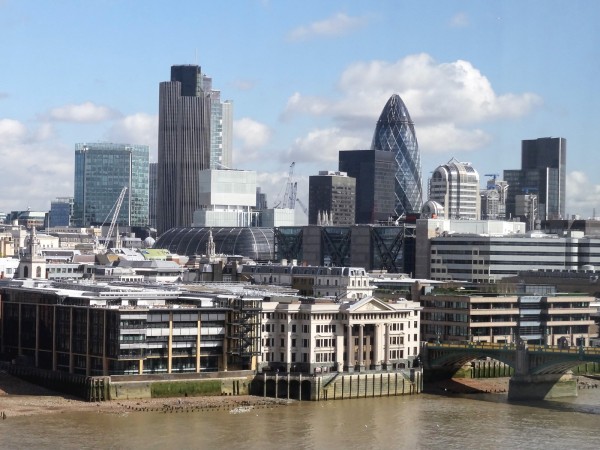 The latest growth data for the UK is somewhat difficult to interpret. It’s positive, but not that positive. The Conservatives say it shows that the economy is moving in the right direction. Labour suggests it is evidence that the Coalition’s policies are not working. With a return to positive growth, the UK has avoided the triple dip recession and here we take a closer look at the economic performance of other key nations.
The latest growth data for the UK is somewhat difficult to interpret. It’s positive, but not that positive. The Conservatives say it shows that the economy is moving in the right direction. Labour suggests it is evidence that the Coalition’s policies are not working. With a return to positive growth, the UK has avoided the triple dip recession and here we take a closer look at the economic performance of other key nations.
In the final quarter of 2012, the US economy grew at 0.4%, but in the 3 months to March 2013, economic growth in America picked up to 2.5%. Consumer spending significantly increased, growing at an annualized rate of 3.2%, according to the Commerce Department. This figure helped boost the growth rate of the US economy, as consumer spending accounts for around two thirds of economic activity.
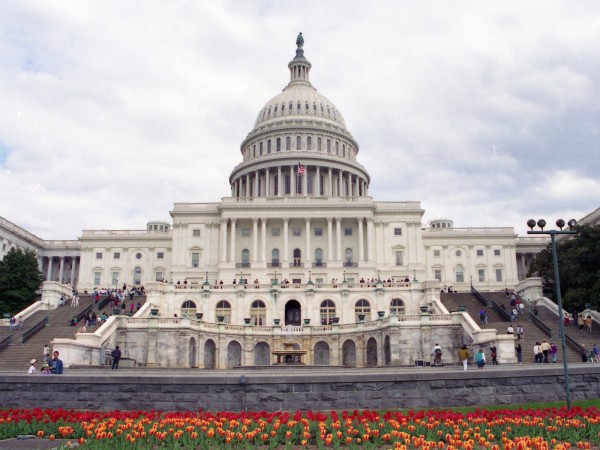 However, the growth figure was lower than expected, in part due to lower government spending. Furthermore, there are suggestions that the positive consumer spending figures are merely a positive blip and spending will fall as the US economy moves through 2013.
However, the growth figure was lower than expected, in part due to lower government spending. Furthermore, there are suggestions that the positive consumer spending figures are merely a positive blip and spending will fall as the US economy moves through 2013.
If this does prove to be the case in the USA, it will do little to further boost UK economic growth, which was recorded at 0.3% for the first 3 months of 2013. The Chancellor has said that the growth figures are encouraging and are evidence that the government’s policies are working.
Today’s figures are an encouraging sign the economy is healing … Despite a tough economic backdrop, we are making progress. We all know there are no easy answers to problems built up over many years, and I can’t promise the road ahead will always be smooth, but by continuing to confront our problems head on, Britain is recovering and we are building an economy fit for the future.
While the USA and UK have recorded positive growth, expectations of growth throughout Europe remain uncertain. Spain has revised its forecasts downwards for 2013, expecting the economy to shrink by over 1%. Even after 2013, growth is expected to remain very weak, forecast to be 0.5% in 2014 and 0.9% in 2015. To make matters worse, Spain’s unemployment continues to move in the wrong direction, with data for the first 3 months of 2013, recording an unemployment rate of 27.2% – the highest on record.
However, it’s not just Spanish unemployment that is on the rise. Figures for March show that in France, 3.2 million people were out of work, a 1.2 % rise compared to February. In the UK, 2.56 million people were recorded as unemployed, representing just under 8% of the working population. The German economy continues to outperform its European partners, but eurozone growth continues to look weak for the rest of 2013.
Despite much bad news in Europe, growth in other parts of the world remains buoyant. South Korea has recorded economic growth that is at its highest level in 2 years. Economic growth was just under 1%, but construction and investment both increased, perhaps a sign of an economy starting its recovery.
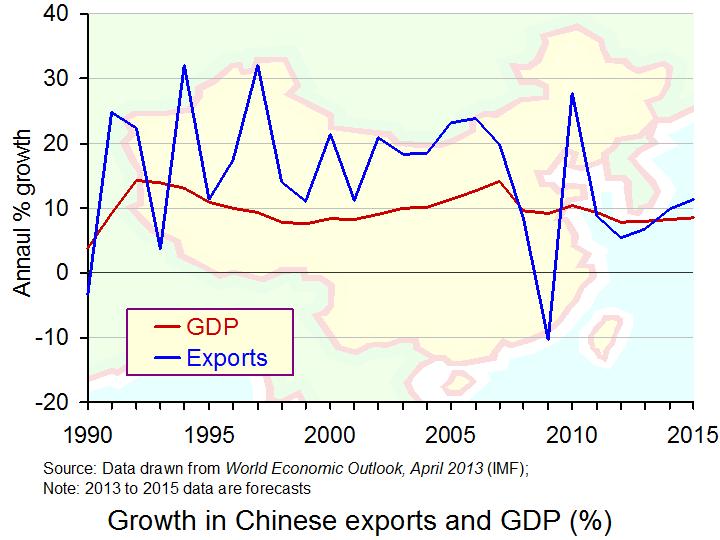 The Chinese economy has seemed relatively unaffected by the economic downturn, yet its economic growth has slowed. Averaging over 10% per annum for the last decade, the growth for January – March 2013 was only 7.7%. This is a decline on the previous 3 months and is lower than expected. If the Chinese economy does begin to slow (relatively speaking), this could present the global economic recovery with an unwelcome obstacle.
The Chinese economy has seemed relatively unaffected by the economic downturn, yet its economic growth has slowed. Averaging over 10% per annum for the last decade, the growth for January – March 2013 was only 7.7%. This is a decline on the previous 3 months and is lower than expected. If the Chinese economy does begin to slow (relatively speaking), this could present the global economic recovery with an unwelcome obstacle.
Many Western economies are reliant on exports to boost their growth figures and with such high demand in China, this is a key export market for many countries. If the Chinese economy continues to slow, consumer spending may even fall and this could mean a reduction in Chinese imports: that is, a reduction in other countries’ exports to China. However, for China’s competitors, the news is better, as with China’s move from a low to middle-income country, other countries will now see an opportunity to grasp a competitive advantage in the production of cheaper products. David Rees from Capital Economics said:
Trade data show that Chinese imports of commodities, and industrial metals in particular, have been falling in recent months … That is bad news for those emerging markets in Latin America, the Middle East, and Africa that predominately export commodities to China. It is not all bad news … To the extent that China’s structural slowdown reflects its transition from low to middle-income status, opportunities will present themselves for other EMs as China moves up the value chain. We are particularly upbeat on the manufacturing-based economies of South East Asia, along with Mexico, Poland, and Turkey.
News is better in Japan, where growth forecasts have been raised to 2.9% over the same period and the economy is expected to grow by 1.5% throughout both 2013 and 2014. Furthermore, suggestions that inflation may also reach 0.7% have boosted confidence. This might be the end of Japan’s troubles with deflation.
So, we have something of a mixed picture across the world, although the IMF predicts a global rate of growth of 3.5% for 2013, which would be an improvement on 2012 figures. The following articles consider the global situation.
Spain slashes economic growth forecast Sky News (26/4/13)
UK avoids triple-dip recession with better than expected 0.3% GDP growth The Guardian, Heather Stewart (26/4/13)
US economy grows 2.5% on buoyant consumer spending BBC News (26/4/13)
Poor French and Spanish jobs data but UK economy returns to growth – as it happened The Guardian, Graeme Wearden and Nick Fletcher (25/4/13)
UK economy avoids tiple-dip recession with 0.3pc GDP growth The Telegraph, Szu Ping Chan (25/4/13)
South Korea economic growth hits two year high BBC News (25/4/13)
S. Korea economy grows at the fastest pace in two years Bloomberg, Eunkyung Seo (25/4/13)
Spain revises down its economic forecast BBC News (26/4/13)
US economy sees broad growth Financial Times, Robin Harding (25/4/13)
Germany’s private sector shrinks as Eurozone decline continues – as it happened The Guardian, Graeme Wearden and Nick Fletcher (23/4/13)
China economic growth lower than forecast BBC News (15/4/13)
China’s slowing economy: what you need to know Bloomberg Business Week, Dexter Roberts (25/4/13)
Modest Growth Pickup in 2013, Projects IMF International Monetary Fund (23/1/13)
Questions
- How is economic growth measured?
- What is meant by a triple-dip recession?
- What has caused the small increase in growth in the UK? Do you think this signifies the start of the economic recovery?
- In the USA, what has caused the growth rate to reach 2.5% and why is it lower than expected?
- Why are growth rates in countries across the world relevant for UK forecasts of economic growth?
- Which factors have allowed the Chinese economy to achieve average growth rates above 10% for the past decade?
- Using an AD/AS diagram, illustrate the desired impact of the Coalition’s policies to boost economic growth.
- With unemployment rising in countries like Spain and France, how might Eurozone growth be affected in the coming months?
- Japanese growth is looking positive and inflation is expected to reach about 0.7%. Why is it that Japan has suffered from deflation for so many years and why is this a problem?
 An excellent learning exercise for students of economics is to take a journal article that uses data to model the economy and then try to replicate the authors’ results. You may well be given an assignment like this in future years of your degree.
An excellent learning exercise for students of economics is to take a journal article that uses data to model the economy and then try to replicate the authors’ results. You may well be given an assignment like this in future years of your degree.
One such exercise is used on the University of Massachusetts Amherst’s doctoral programme in economics. Thomas Herndon is a student on that degree and chose to examine a well-known and highly influential paper, Growth in a Time of Debt by Carmen Reinhart then of the University of Maryland and Kenneth Rogoff of Harvard University and former chief economist of the IMF. Professors Reinhart and Rogoff used new data on 44 countries spanning about 200 years.

A key finding of their paper, published in 2010 in the American Economic Review Papers and Proceedings, is that once a country’s government debt exceeds 90% of GDP, growth rates fall considerably: the median across countries by about 1% and the mean considerably more.
The paper has been hugely influential. It has been used to justify the austerity programmes being pursued in many countries, including the UK and the eurozone. Cutting the government deficit to GDP ratio, and ultimately the government debt to GDP ratio, has been seen as a way of achieving higher growth over the longer term, and justifies the adverse effect on short-term growth from the dampening of aggregate demand.
Well, this seemed an interesting paper for Thomas Herndon to examine, and he was keen to show just how Reinhart and Rogoff’s data led to their conclusions. But try as he might, he could not replicate their results. His initial reaction was to think he had made an error, but each time he checked he came back with the same conclusion: they must have made errors in their calculations.
His supervisor at Amherst, Professor Michael Ash, after Thomas had checked and checked again, realised that something was wrong. He encouraged Thomas to write to Reinhart and Rogoff to request sight of their dataset. They duly obliged and it was then that Thomas spotted various errors. These are explained in the articles below, but the overall effect was to alter the conclusion. Although high debt may undermine growth to some extent, the effect is much less than Reinhart and Rogoff concluded, and there are several exceptions to this rule.
On 15 April 2013, Thomas, along with his supervisor, Michael Ash and his colleague, Robert Pollin, published a response to the Reinhart and Rogoff paper. In the abstract to their paper, Does High Public Debt Consistently Stifle Economic Growth? A Critique of Reinhart and Rogoff they state that:
… coding errors, selective exclusion of available data, and unconventional weighting of summary statistics lead to serious errors that inaccurately represent the relationship between public debt and GDP growth among 20 advanced economies in the post-war period. They find that when properly calculated, the average real GDP growth rate for countries carrying a public-debt-to-GDP ratio of over 90 percent is actually 2.2 percent, not –0:1 percent as published in Reinhart and Rogoff. That is, contrary to RR, average GDP growth at public debt/GDP ratios over 90 percent is not dramatically different than when debt/GDP ratios are lower.
The authors also show how the relationship between public debt and GDP growth varies significantly by time period and country. Overall, the evidence we review contradicts Reinhart and Rogoff’s claim to have identified an important stylized fact, that public debt loads greater than 90 percent of GDP consistently reduce GDP growth.
So could this be you in the future? Will you take a famous paper and, by re-examining and reworking the data, find that its conclusions are wrong? Could you end up changing the world? Exciting stuff!
Podcasts
 Austerity: A Spreadsheet Error? BBC, More or Less, Tim Harford (20/4/13)
Austerity: A Spreadsheet Error? BBC, More or Less, Tim Harford (20/4/13)
 Austerity justification study ‘inaccurate’ BBC Today Programme, Robert Pollin (18/4/13)
Austerity justification study ‘inaccurate’ BBC Today Programme, Robert Pollin (18/4/13)
Articles
UMass Student Exposes Serious Flaws in Harvard Economists’ Influential Study The Atlantic Wire, J.K. Trotter (18/4/13)
Shocking Paper Claims That Microsoft Excel Coding Error Is Behind The Reinhart-Rogoff Study On Debt Business Insider, Mike Konczal (16/4/13)
How a student took on eminent economists on debt issue – and won Economic Times of India (19/4/13)
Meet the 28-Year-Old Grad Student Who Just Shook the Global Austerity Movement New York Magazine, Kevin Roose (19/4/13)
An economist’s mea culpa: I relied on Reinhart and Rogoff Confessions of a Supply-Side Liberal blog, Miles Kimball (22/4/13)
The Rogoff-Reinhart data scandal reminds us economists aren’t gods The Guardian, Heidi Moore (18/4/13)
Reinhart, Rogoff… and Herndon: The student who caught out the profs BBC News Magazine, Ruth Alexander (20/4/13)
George Osborne’s case for austerity has just started to wobble The Guardian, Polly Toynbee (18/4/13)
The error that could subvert George Osborne’s austerity programme The Guardian, Charles Arthur and Phillip Inman (18/4/13)
The Excel depression Sydney Morning Herald, Paul Krugman (19/4/13)
Europe: Retreat from austerity BBC News, Gavin Hewitt (23/4/13)
Guest post by Thomas Herndon
The Grad Student Who Took Down Reinhart And Rogoff Explains Why They’re Fundamentally Wrong Business Insider, Thomas Herndon (22/4/13)
Papers
Growth in a Time of Debt NBER working paper, Carmen M. Reinhart and Kenneth S. Rogoff (January 2010)
Does High Public Debt Consistently Stifle Economic Growth? A Critique of Reinhart and Rogo�ff PERI Working Paper 322, Thomas Herndon, Michael Ash and Robert Pollin (April 2013)
Questions
- What were the particular errors made by Reinhart and Rogoff?
- How has their paper been used as a basis for the design of macroeconomic policy?
- What are the limitations of using even accurate time-series data as the basis for policy measures?
- How might the work of Herndon change the direction of future macroeconomic policy?
- In his guest post in Business Insider (see link above), Herndon wrote: ‘The implication for policy is that, under particular circumstances, public debt can play a key role in overcoming a recession.’ What might this role be?
- Why might we have to be cautious in drawing policy conclusions from Herndon’s work?
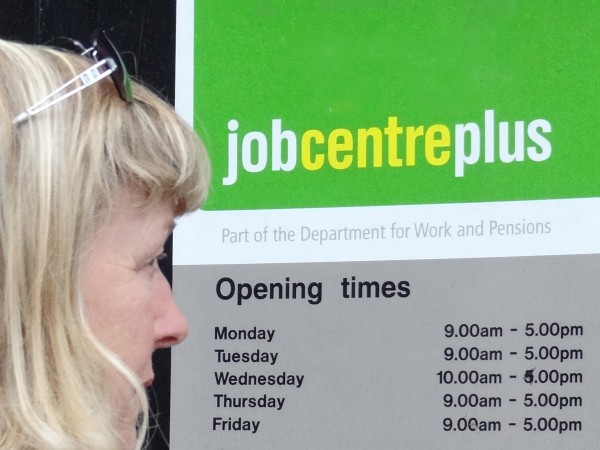 Unemployment is a key macroeconomic objective for governments across the world. The unemployment rate for the UK now stands at 7.9% according to the ONS, which recorded 2.56 million people out of work. But why is unemployment of such importance? What are the costs?
Unemployment is a key macroeconomic objective for governments across the world. The unemployment rate for the UK now stands at 7.9% according to the ONS, which recorded 2.56 million people out of work. But why is unemployment of such importance? What are the costs?
The economy is already in a vulnerable state and with unemployment rising by 70,000 people between December and February 2013, the state of the economic recovery has been questioned. Indeed, following the news of the worsening unemployment data, the pound fell significantly against the dollar, suggesting a lack of confidence in the British economy.
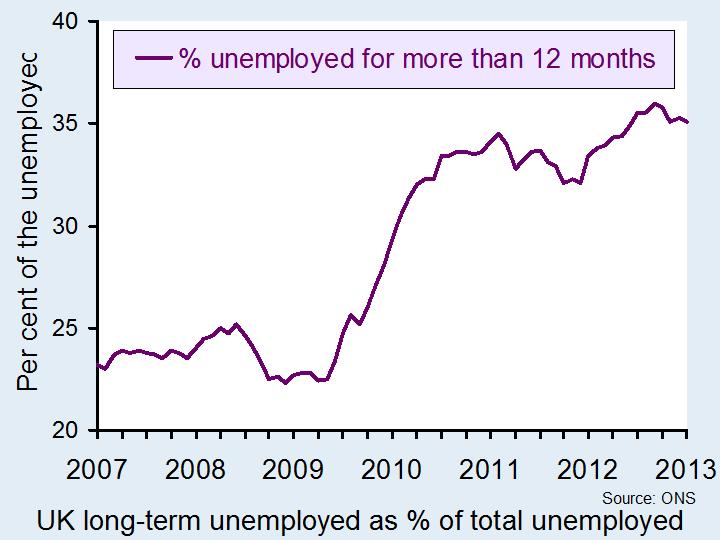 Although the increase in the number of people out of work is concerning, perhaps of more concern should be the number of long-term unemployed. The ONS suggests that more than 900,000 have now been out of work for more than a year. Not only does this pose costs for the individual in terms of lost earnings and skills, but it also imposes costs on friends and family and the wider economy. (Click here for a PowerPoint of the first chart, which shows the percentage of unemployed people out for work longer than 12 months.)
Although the increase in the number of people out of work is concerning, perhaps of more concern should be the number of long-term unemployed. The ONS suggests that more than 900,000 have now been out of work for more than a year. Not only does this pose costs for the individual in terms of lost earnings and skills, but it also imposes costs on friends and family and the wider economy. (Click here for a PowerPoint of the first chart, which shows the percentage of unemployed people out for work longer than 12 months.)
The chief executive of the Prince’s Trust focused on the costs of youth unemployment in particular, saying:
Thousands of these young people are long-term unemployed, often facing further challenges such as poverty and homelessness. We must act now to support these young people into work and give them the chance of a better future.
(Click here for a PowerPoint of the second chart, which shows how much higher the unemployment rate is for young people aged 18 to 24 than it is for the working age population as a whole.)
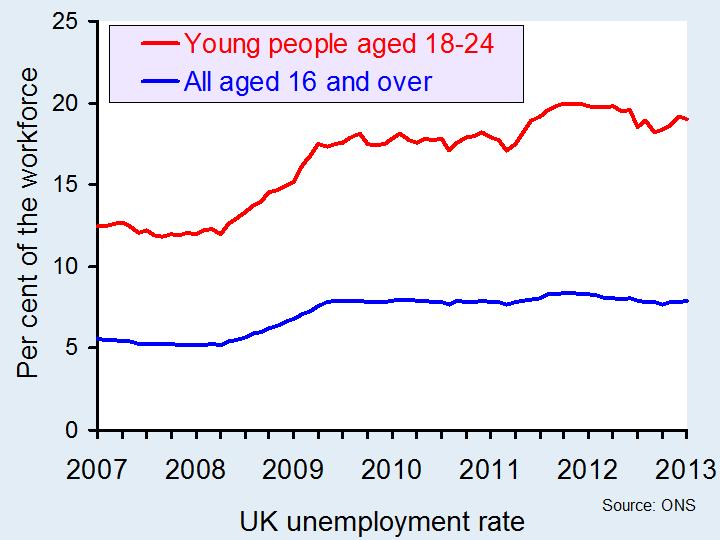 Furthermore, with so many people unemployed, we are operating below full-employment and thus below our potential output. Furthermore, the longer people are out of work, the more likely it is that they will lose their skills and thus require re-training in the future or find that there are now fewer jobs available to them based on their lower skill level.
Furthermore, with so many people unemployed, we are operating below full-employment and thus below our potential output. Furthermore, the longer people are out of work, the more likely it is that they will lose their skills and thus require re-training in the future or find that there are now fewer jobs available to them based on their lower skill level.
In addition to this there are monetary costs for the government through lower tax receipts, in terms of income tax, national insurance contributions and even VAT receipts. With more people unemployed, the numbers claiming various unemployment-related benefits will rise, thus imposing a further cost on the government and the taxpayer. Another cost to the government of this latest data is likely to be the expectations of the future course of the economy. Numerous factors affect business confidence and unemployment data is certainly one of them. The concern is that business confidence affects many other variables as well and until we receive more positive data, the economy recovery is likely to remain uncertain. The following articles consider this topic.
UK unemployment rise adds to pressure on Osborne’s austerity strategy The Guardian, Phillip Inman (18/4/13)
Unemployment figures are ‘worrying’, David Cameron’s spokesman says The Telegraph, Peter Dominiczak (17/4/13)
UK unemployment rises to 2.56 million BBC News (17/4/13)
Unemployment jumps to 7.9% as rise in the number of young people out of work takes figure ‘dangerously’ close to a million Mail Online, Leon Watson (17/4/13)
Unemployment up as stay-at-home mothers head back to the job-centre Independent, Ben Chu (17/4/13)
Jobs data points to finely balanced market Financial Times, Brian Groom (18/4/13)
 Hugh’s review: making sense of the stats BBC News (19/4/13)
Hugh’s review: making sense of the stats BBC News (19/4/13)
Questions
- How is unemployment measured?
- What are the costs to the individual of being unemployed?
- What are the wider non-monetary costs to society?
- Explain the main financial costs to the wider economy of a rising unemployment rate.
- Illustrate the problem of unemployment by using a production possibility frontier.
- Could there be a negative multiplier effect from a rise in unemployment?
 The UK economy shrank by 0.3 per cent in the final quarter of 2012. A significant factor in the fall was the UK’s balance of trade, which measures the difference between the value of goods and services exported and those imported. The balance of trade deficit rose in 2012 to £36.2 billion or 2.3 per cent of GDP. If we measure only the balance in goods, the deficit was an eye-watering £106.3 billion – a record high for the UK. The balance of trade remains a drag on British growth.
The UK economy shrank by 0.3 per cent in the final quarter of 2012. A significant factor in the fall was the UK’s balance of trade, which measures the difference between the value of goods and services exported and those imported. The balance of trade deficit rose in 2012 to £36.2 billion or 2.3 per cent of GDP. If we measure only the balance in goods, the deficit was an eye-watering £106.3 billion – a record high for the UK. The balance of trade remains a drag on British growth.
The balance of payments is a record all the flows of money between a country’s residents and the rest of the world. Inflows represent credits on the balance of payments while outflows represent debits. We focus here on perhaps the best-known component of the overall balance of payments: the current account. The current account comprises three separate accounts. First, there is the balance of trade (in goods and services). It records payments for exports (X) and imports (M). Second, there is net income flows. Net income flows are flows of money between countries in the form of wages, profits and interest. Finally, there is current transfers. Current transfers are transfers of money between countries for the purpose of consumption, including, for instance, a transfer payment by the British government to overseas organisations.
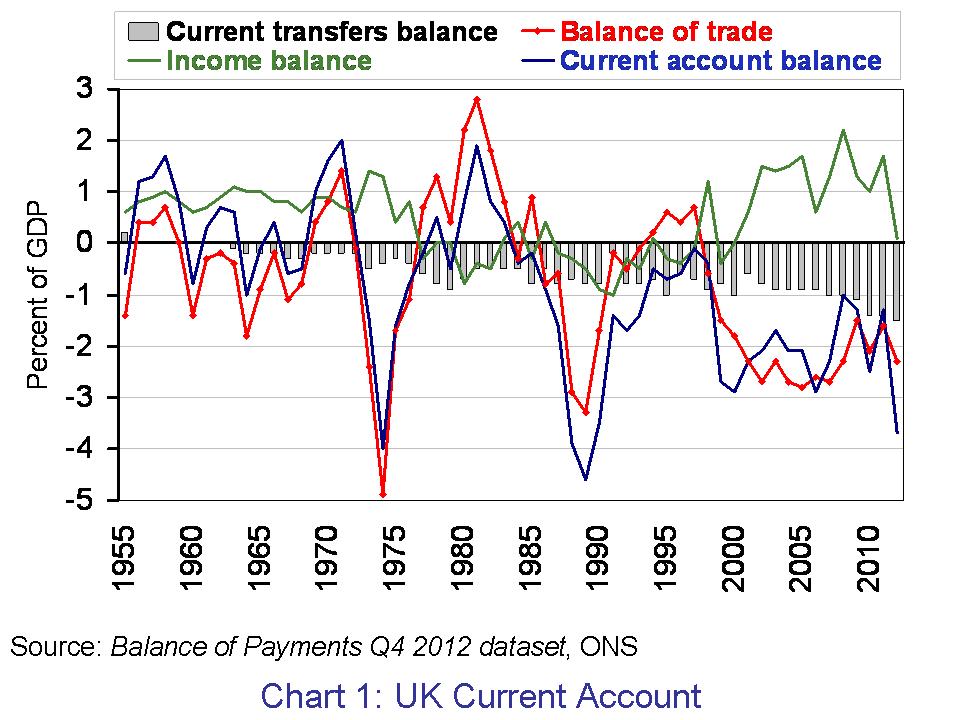
Chart 1 presents the UK’s current account. It is based on data from Balance of Payments Q4 2012 dataset published by the Office for National Statistics. The current account deficit in 2012 was £57.7 billion (up from a deficit of £20.2 billion in 2011). This is the equivalent to 3.7 per cent of GDP (up from a deficit of 1.3 per cent in 2011) and the highest current account deficit since 1989 when it reached 4.6 per cent of GDP. Back in 1989, the UK economy was growing by 2.6 per cent having grown by 5.6 per cent in 1988. In 2012, the UK economy grew by just 0.3 per cent following growth of 1.0 per cent in 2011. The mean average rate growth of the UK economy since 1950 is 2.6 per cent. (Click here for a PowerPoint of the chart.)
The net income balance, which while remaining in surplus, worsened significantly. From a surplus of £25.9 billion (1.7 per cent of GDP) in 2011, it fell to a surplus of just £1.6 billion (0.1 per cent of GDP) in 2012. This is largely attributable to a decline in the surplus of direct investment income and, in particular, the earnings abroad of non-bank private corporations. Meanwhile, the deficit on current transfers in 2012 was £23.1 billion, up from £22.0 billion in 2011. This is the highest on record. The current transfers deficit with EU institutions rose in 2012 to £10.5 billion, up by £1 billion on 2011.
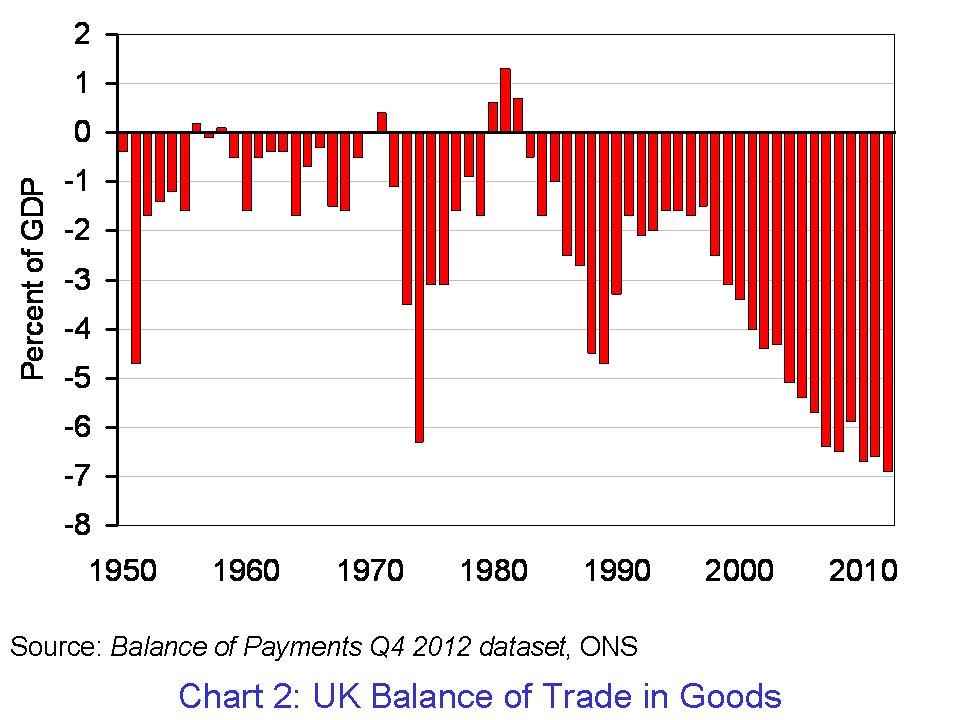
The balance of trade deficit too worsened in 2012. The deficit rose from £24.1 billion in 2011 (1.6 per cent of GDP) to £36.2 billion in 2012 (2.3 per cent of GDP). The persistent balance of trade deficit continues to occur despite a persistent surplus on the trade in services. In 2012, the balance of trade surplus in services was £70 billion (4.6 per cent of GDP). As Chart 2 shows, the UK now has a record deficit in the balance of trade in goods. This was down from £76.1 billion in 2011 (5 per cent of GDP). (Click here for a PowerPoint of the chart.)
The last time the UK ran a surplus on the balance of trade in goods was back in 1982. Since 1983, the average UK balance of trade deficit in goods has been the equivalent of 3.67 per cent of GDP. Over the same period, the UK has run a balance of trade surplus in services of 2.37 per cent. The figures point very clearly to the work to be done if we are to see a rebalancing of the industrial composition of the UK economy.
Data
Statistical Bulletin: Balance of Payments, Q4 2012 ONS, 27 March 2013
Balance of Payments, Q4 2012 dataset ONS, 27 March 2013
Articles
Fasten your seat belts – a balance of payments crisis looms Telegraph, Jeremy Warner 27/3/13)
Britain, the world and the end of the free lunch? BBC News, Stephanie Flanders (27/3/13)
March of the makers? Balance of payments figures make dismal reading Guardian, Larry Elliott (27/3/13)
Britain’s current account deficit at worst level since 1989 Guardian, Phillip Inman (27/3/13)
Pound fears as current account deficit jumps to near 25 per cent high Telegraph, Szu Ping Chan (27/3/13)
Current account deficit highest since 1989 Financial Times, Claire Jones (27/3/13)
Questions
- What does the balance of payments measure?
- In explaining what the current account of the balance of payments measures, distinguish between the three principal accounts comprising the current account.
- Why might we expect the current account to worsen when economic growth is strongest and improve when economic growth is weakest? Is this what we observe in the UK?
- The UK has experienced a persistent current account deficit since the early 1980s. What might be some of the contributory factors to this persistent deficit?
- How might we expect a country’s exchange rate to be affected by movements on the balance of payments?
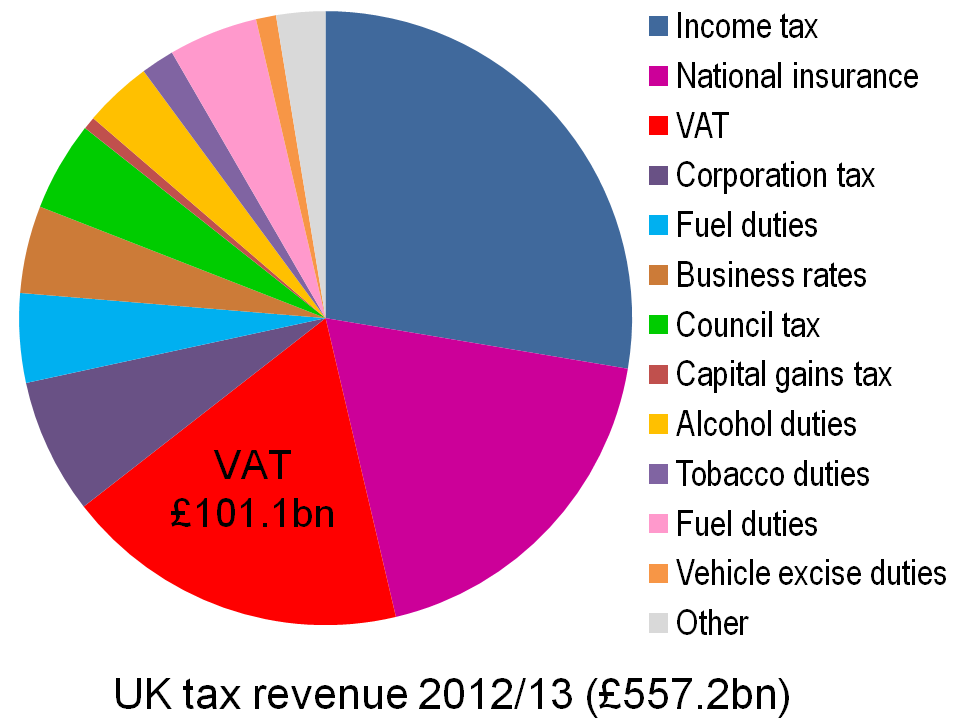 VAT was introduced on the 1st of April 1973, as part of the conditions for the UK entering the Common Market. Designed by a French tax expert, Maurice Lauré, it was initially envisaged as a straightforward replacement for purchase tax, which would be applied to most goods and services.
VAT was introduced on the 1st of April 1973, as part of the conditions for the UK entering the Common Market. Designed by a French tax expert, Maurice Lauré, it was initially envisaged as a straightforward replacement for purchase tax, which would be applied to most goods and services.
Forty years on, VAT is increasingly complex, with numerous exemptions, many anomalies in its scope, and increasingly expensive challenges to its imposition. How did we get to this point? And is it time for VAT to undergo a mid-life makeover?
All governments have to raise taxes – to redistribute income and to fund public spending. They have a number of mechanisms they can use, but essentially they have to tax incomes (direct taxes), spending (indirect taxes) or a mix of both. The main indirect tax in the UK is VAT, which now raises over £100bn a year, compared with £1.5bn in its first year (see above chart: click here for a PowerPoint version). Initially envisaged as a simple, cross-Europe purchase tax, the current system is complex and at times appears to have been formulated ‘on the hoof’, never a good way to build a tax system.
In the 2012 Budget, the Chancellor decided to apply the standard rate of income tax to hot takeaway pasties; previously they had been zero-rated. However, he had sharply underestimated the ability of the industry to lobby against the tax, working closely with the tabloid press. Perhaps more importantly, he also missed the complex nature of the good; when is a hot pasty just cooling down? And what is hot? The government backtracked and now 20% VAT is only charged on pasties that are deliberately kept hot. You might think that this change of heart avoided introducing an anomaly, but consider how you might feel if you sell takeaway baked potatoes, which are subject to VAT.
Apart from the complexity of the system, VAT is unpopular with some commentators who feel that it falls too heavily on low-income households. Although many foodstuffs are zero-rated and housing is exempt, VAT is charged at 20% on clothing and many necessities such as cleaning materials. Gas and electricity are subject to a reduced rate of 5% and both alcohol and cigarettes have additonal excise duties imposed and yet are disproportionally consumed by the poor. When the standard rate of VAT was temporarily dropped to 15% in 2010, but then permanently raised to 20% in 2011, many felt that this was a shift in the tax burden to the poor.
So complex, irrational and prone to changes following political lobbying or expensive legal cases, VAT does seem to be stumbling into its forties under something of a cloud. However, it remains the case that it raises a large proportion of UK tax revenues at relatively low direct cost and provides the Chancellor with a reasonably effective fiscal policy tool. Even if a government wanted to put in place an alternative, it is likely that the associated political risks would be too high for it to do so. We might hope for some rationalisation of the current system, but there is little doubt that we will be raising a glass to VAT’s 50th birthday in 2023.
The links below include some articles on VAT’s 40th birthday and some more general articles on VAT.
Articles
VAT is 40 years old- and now has middle-age spread The Guardian, Juliette Garside (31/1/13)
Is VAT suffering a mid-life crisis at 40? BBC News, Colin Corder (31/3/13)
VAT at 40, not simple, not popular, but central to government revenue-raising The Chartered Institute of Taxation (28/3/13)
Happy birthday VAT, here’s how not to pay you The Telegraph, Rosie Murray-West (31/3/13)
Poorest spend higher proportion of VAT than richest BBC News (31/10/11)
A Value- Added Tax offers much to love- and hate New York Times, Gregory Mankiw (1/5/10)
EC Standard VAT Declaration European Commission Roadmap (2012)
Data and information
VAT pages HMRC
Public sector finance statistics HM Treasury (follow link to latest Public finances databank (Excel file) and go to Worksheet C2)
Latest European Union EU VAT rates VATLive
Questions
- Explain why VAT might be deemed regressive. Can you formulate an argument that it falls more heavily on the rich than the poor?
- Why is VAT administratively cheap? Other than generating tax revenues, can you think of any advantages of the tax?
- Newspapers and books are zero-rated in the UK, while e-books and news apps are standard rated at 20%. Can you identify some other anomalies in the UK VAT system? Is there an argument that a better approach would be to charge a lower rate on all goods and services?
- Who pays VAT, consumers or producers? Illustrate your answer with a diagram, or two.
- A business has to register for VAT once it has a turnover of £77,000 pa. Does this system give rise to any perverse incentives?
- Countries across the European Union have varying VAT rates, applied to very different ranges of products. Explain why this might hinder the workings of a single European market.
- Imagine you were running a brand new economy; would you use a value-added tax to raise revenues? What are the alternatives open to governments?
 The latest growth data for the UK is somewhat difficult to interpret. It’s positive, but not that positive. The Conservatives say it shows that the economy is moving in the right direction. Labour suggests it is evidence that the Coalition’s policies are not working. With a return to positive growth, the UK has avoided the triple dip recession and here we take a closer look at the economic performance of other key nations.
The latest growth data for the UK is somewhat difficult to interpret. It’s positive, but not that positive. The Conservatives say it shows that the economy is moving in the right direction. Labour suggests it is evidence that the Coalition’s policies are not working. With a return to positive growth, the UK has avoided the triple dip recession and here we take a closer look at the economic performance of other key nations. However, the growth figure was lower than expected, in part due to lower government spending. Furthermore, there are suggestions that the positive consumer spending figures are merely a positive blip and spending will fall as the US economy moves through 2013.
However, the growth figure was lower than expected, in part due to lower government spending. Furthermore, there are suggestions that the positive consumer spending figures are merely a positive blip and spending will fall as the US economy moves through 2013. The Chinese economy has seemed relatively unaffected by the economic downturn, yet its economic growth has slowed. Averaging over 10% per annum for the last decade, the growth for January – March 2013 was only 7.7%. This is a decline on the previous 3 months and is lower than expected. If the Chinese economy does begin to slow (relatively speaking), this could present the global economic recovery with an unwelcome obstacle.
The Chinese economy has seemed relatively unaffected by the economic downturn, yet its economic growth has slowed. Averaging over 10% per annum for the last decade, the growth for January – March 2013 was only 7.7%. This is a decline on the previous 3 months and is lower than expected. If the Chinese economy does begin to slow (relatively speaking), this could present the global economic recovery with an unwelcome obstacle.








